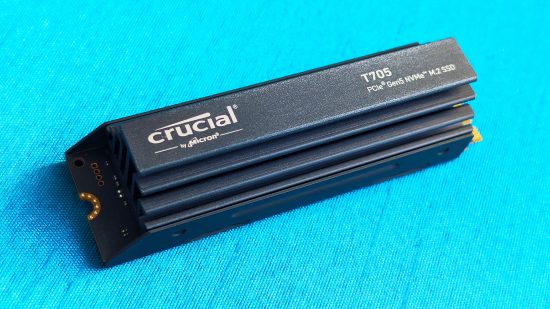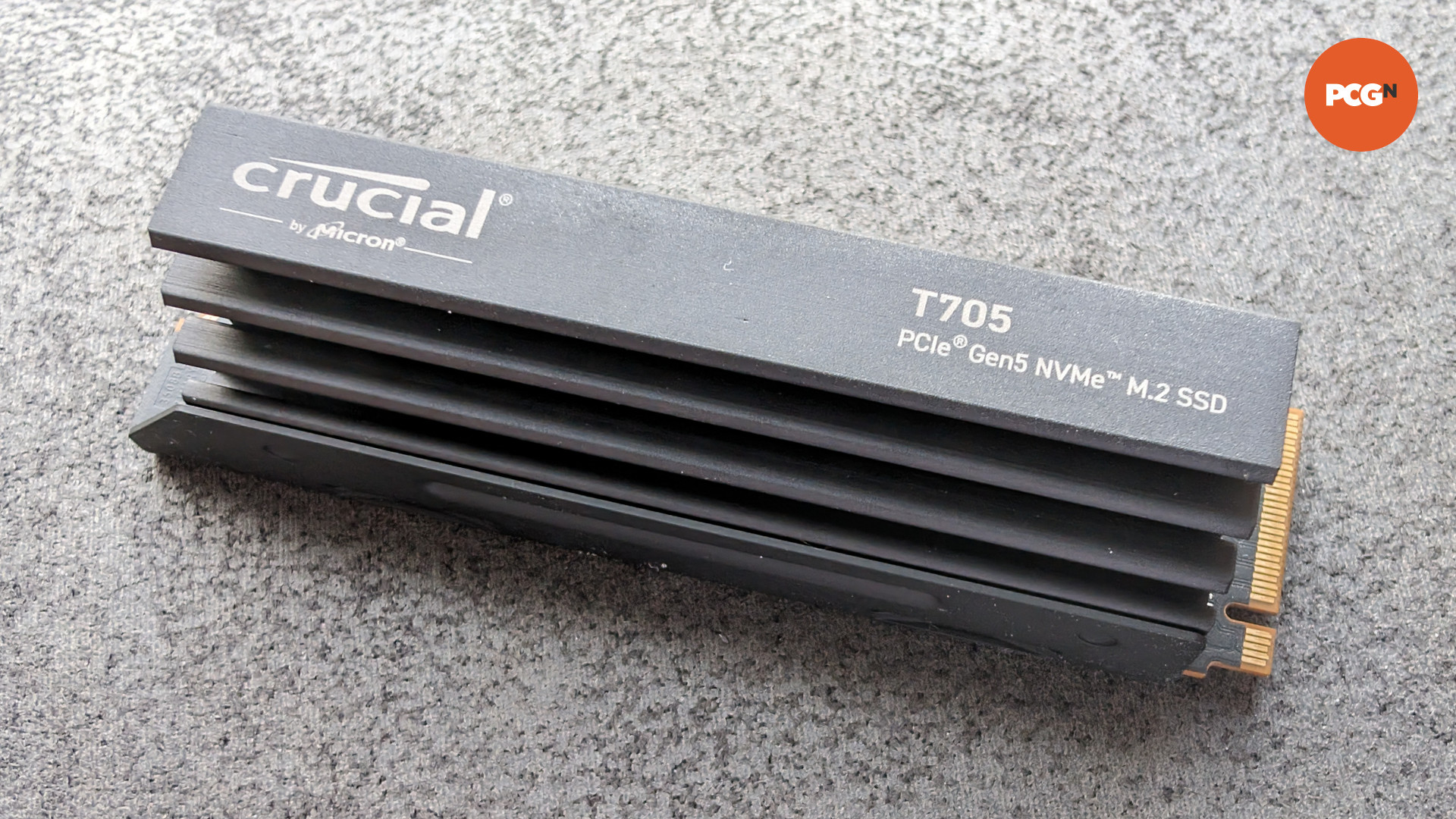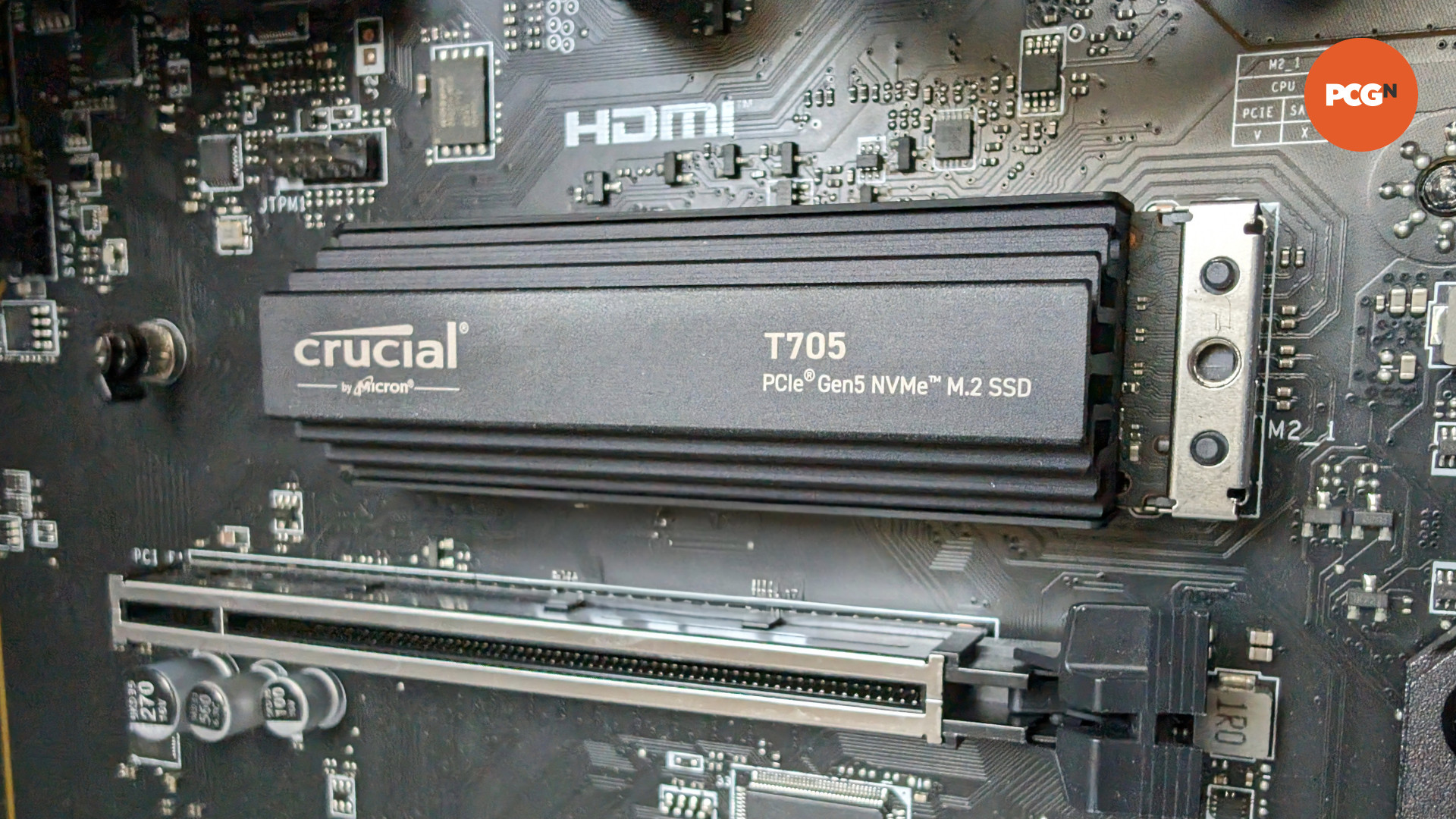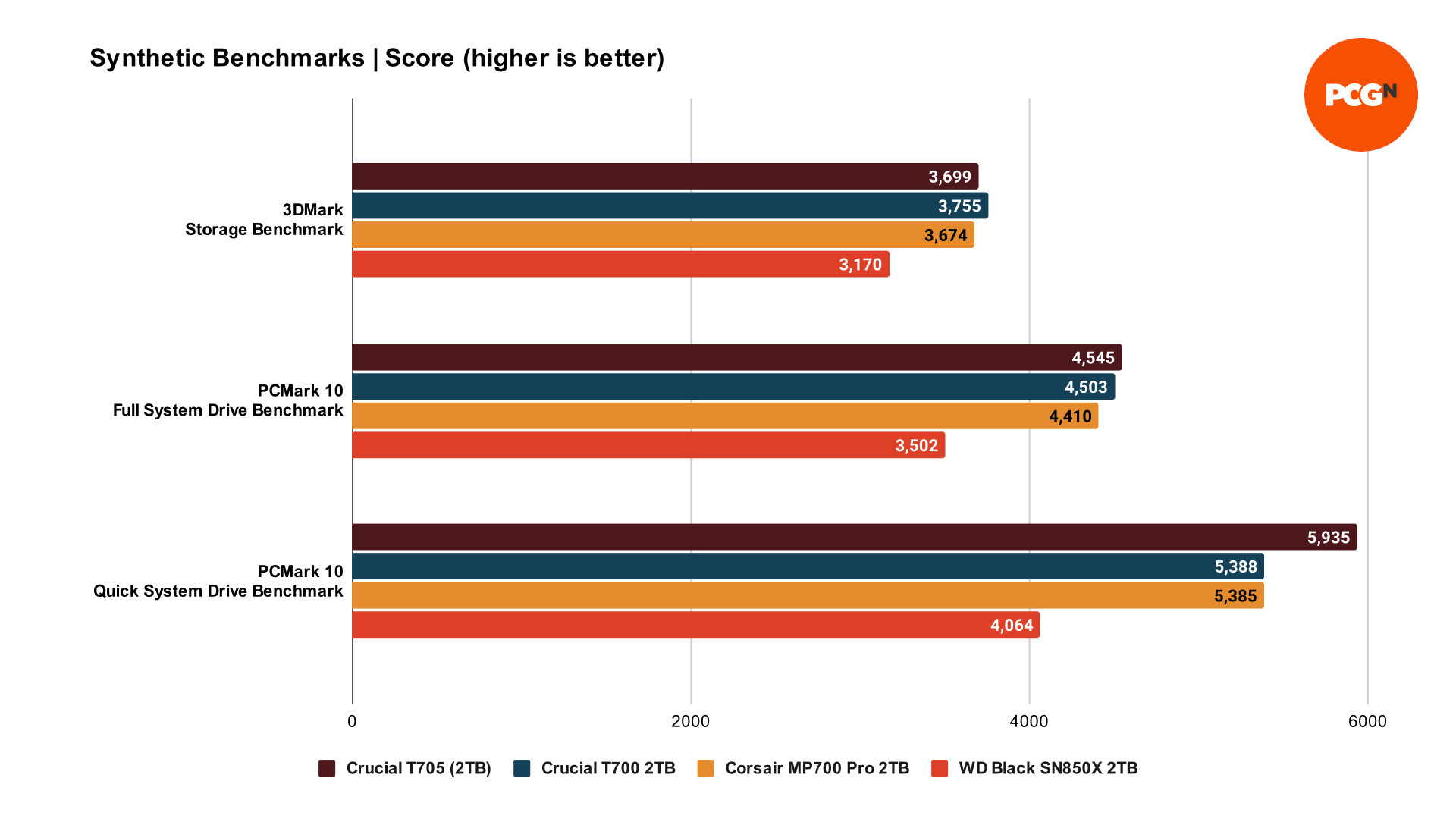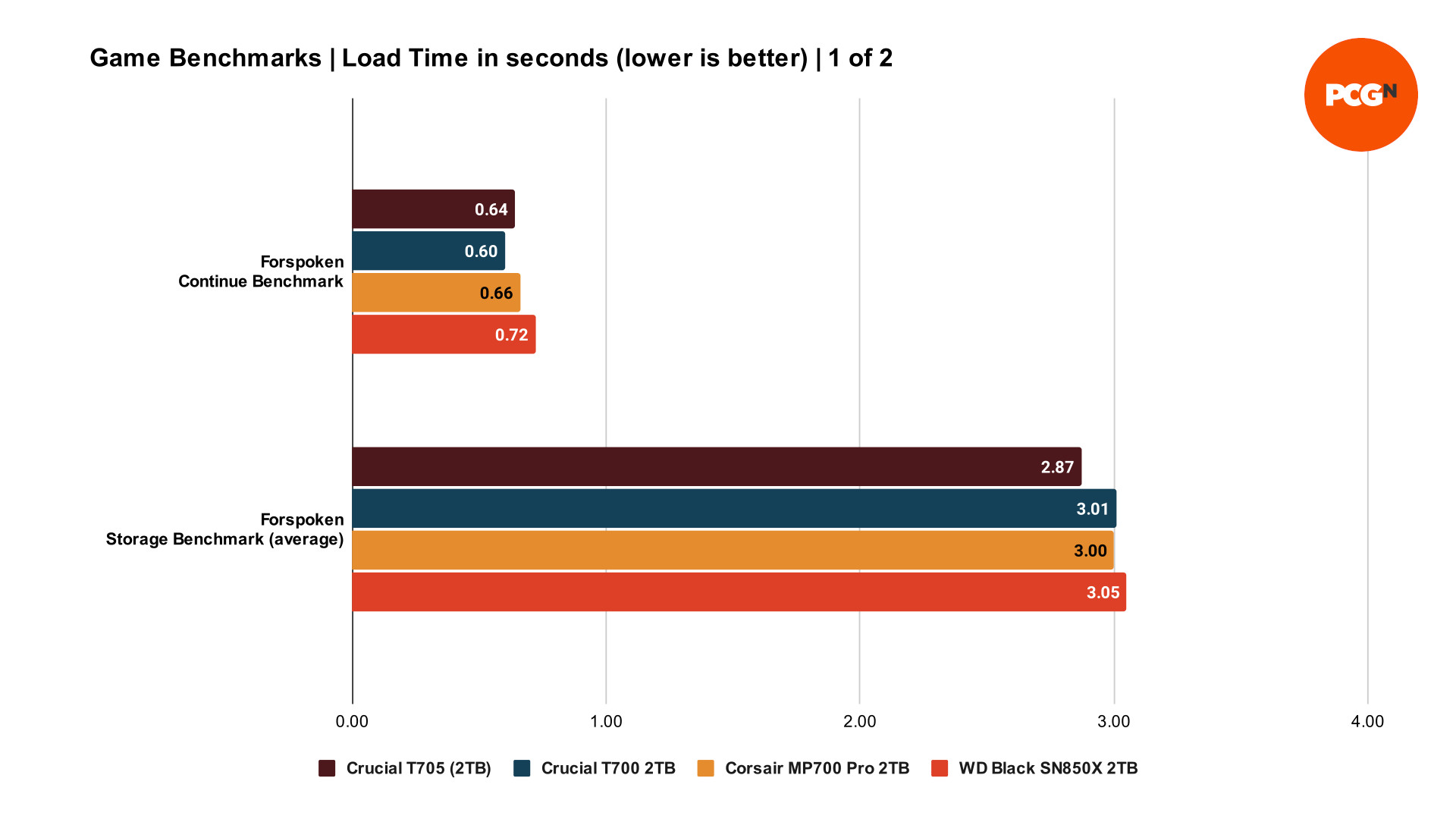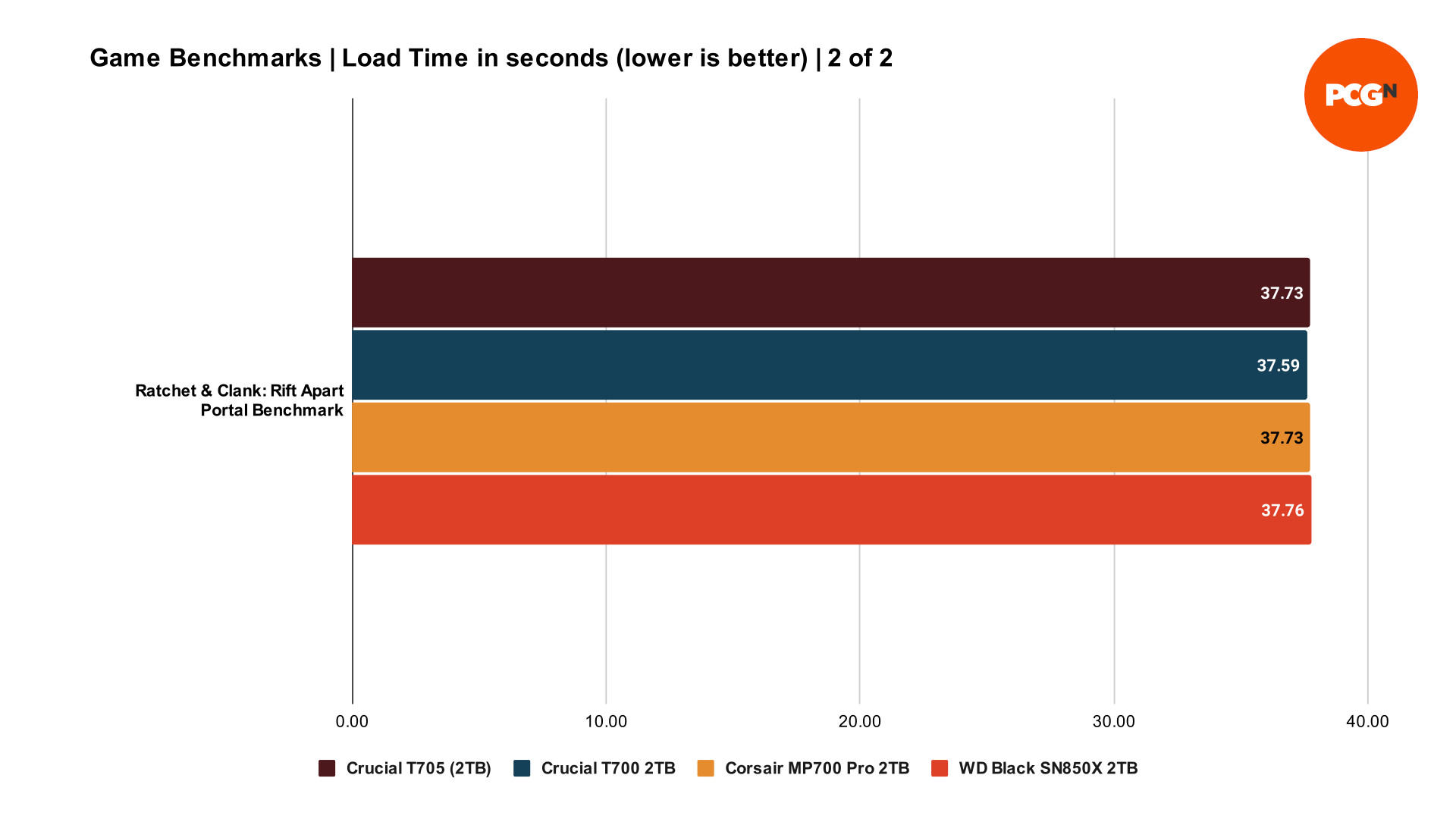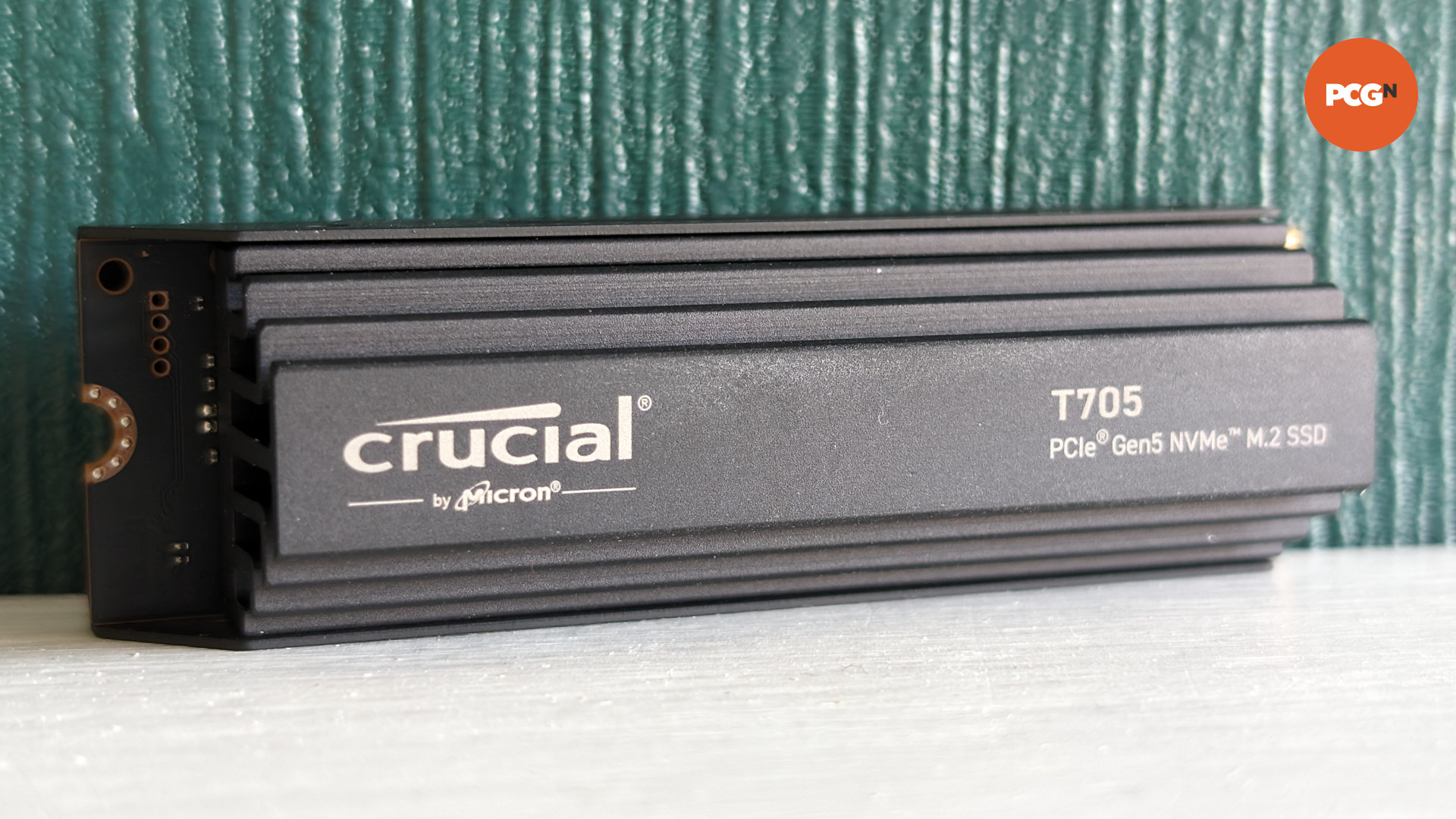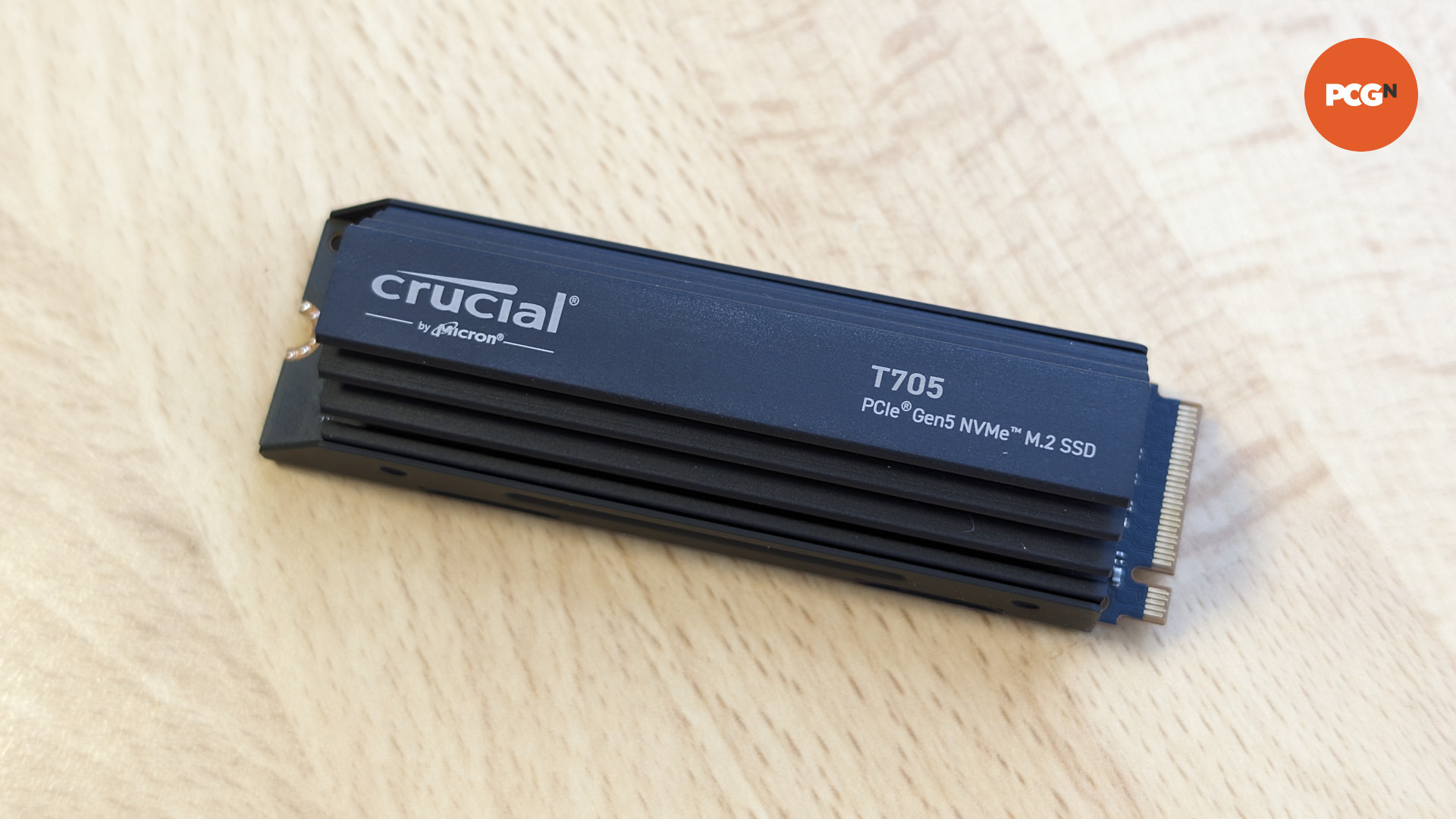Our Verdict
The Crucial T705 is the SSD to beat as raw speed goes, featuring sequential reads and writes that can not be beaten by other drives. However, its power comes at the cost of heat that the optional passive heatsink isn't always up to the task of managing, leading to potential performance problems. Add a high asking price into the mix, and we are left with impressive if unruly solid-state storage.
- Up to 14.5GB/s read speeds
- 1TB, 2TB, and 4TB capacities
- Good endurance and warranty
- Pricey
- Can thermal throttle under load
- No active cooling options
After achieving the fastest speeds seen on a PCIe 5.0 NVMe SSD with the T700, the Crucial T705 sees solid-state read and write speeds pushed further still. Now, we have a drive that runs just shy of twice as fast as the best examples of PCIe 4.0 storage. While this feat is impressive, though, its benefits are not immediately apparent, especially in gaming, and the potential for thermal throttling sandbags an otherwise excellent, if expensive, SSD.
Why you can trust our advice ✔ At PCGamesN, our experts spend hours testing hardware and reviewing games and VPNs. We share honest, unbiased opinions to help you buy the best. Find out how we test.
On paper, the T705 is naturally primed to join the ranks of the very best SSDs you can slot into your system, boasting the fastest sequential read speeds on the market. The reality, however, is not so simple. Running the Crucial drive through our test suite, in addition to capturing fresh data from competing PCIe 5.0 NVMe SSDs, reveals that being fast will only get you so far.
Crucial T705 specs
The T705 is available in 4TB, 2TB, and 1TB capacities, each with their own slightly different sequential read and write speeds. The difference between them amounts to 900MB/s, with the 1TB model being the slowest, and the 2TB drive being the fastest, and it’s the latter model we are reviewing. This drive in particular boasts 14,500MB/s sequential reads and 12,400MB/s writes, giving it respective 2,100MB/s and 1,100MB/s leads over the best version of its predecessor, the Crucial T700.
| Crucial T705 | Crucial T700 | |
| Sequential read speed (up to) | 14,100MB/s (4TB) 14,500MB/s (2TB) 13,600MB/s (1TB) |
12,400MB/s (4TB) 12,400MB/s (2TB) 11,700MB/s (1TB) |
| Sequential write speed (up to) | 12,600MB/s (4TB) 12,700MB/s (2TB) 10,200MB/s (1TB) |
11,800MB/s (4TB) 11,800MB/s (2TB) 9,500MB/s (1TB) |
| DRAM cache size | 4GB (4TB) 2GB (2TB) 1GB (1TB) |
4GB (4TB) 2GB (2TB) 1GB (1TB) |
| Heatsink option(s) | Passive | Passive |
| NAND flash | TLC | TLC |
| Controller | Phison PS5026-E26 | Phison PS5026-E26 |
| Endurance rating | 2,400TB (4TB) 1,200TB (2TB) 600TB (1TB) |
2,400TB (4TB) 1,200TB (2TB) 600TB (1TB) |
| Warranty | Five years | Five years |
| Price | $689.99 (4TB) $399.99 (2TB) $239.99 (1TB) |
$599.99 (4TB) $339.99 (2TB) $179.99 (1TB) |
Aside from their speeds, the T700 and T705 are near-identical. Both these drives use the Phison PS5026-E26 controller, as well as the same passive heatsink option. Given that the T705 runs even quicker than the T700, and thus hotter, I had hoped that Crucial would have either beefed up the cooling system from the older drive or provided alternative active options, but this is sadly not the case.
The DRAM cache size and endurance rating of the T700 falls slightly short of competitors like the Corsair MP700 Pro, but the shortfall is not so significant as to be worrisome. Still, given the $70-$100 price difference between the two drives, every blemish no matter the size becomes more noteworthy.
Crucial T705 performance
We put the T705 through an assortment of synthetic and game benchmarks, designed to showcase its performance in a variety of scenarios. Applications for the former type of testing include 3DMark, CrystalDiskMark, and PCMark 10, while the latter is made up of Forspoken and Ratchet & Clank: Rift Apart, both of which support DirectStorage.
| SSD test PC specs | |
| SSD | Crucial T705 (with passive heatsink) |
| OS | Windows 11 Pro 23H2 (22631.3155) |
| CPU | AMD Ryzen 7 7800X3D |
| CPU cooler | Corsair iCue H150i Elite Capellix XT |
| RAM | Corsair Vengeance 32GB (2 x 16GB) DDR5 6,000MHz |
| Motherboard | Asus TUF Gaming X670E-Plus (BIOS version 2413) |
| GPU | Nvidia GeForce RTX 4090 Founders Edition |
| Driver | GeForce Game Ready (551.61) |
| PSU | Corsair RMx Shift Series 1,000W |
| Case | Corsair 5000D RGB Airflow |
Crucial T705 synthetic benchmarks
The T705 naturally pulls ahead of other, slower, PCIe 5.0 NVMe SSDs we have tested with PCMark 10, namely the T700 and MP700 Pro, and does markedly better than the WD Black SN850X, one of the better examples of a PCIe 4.0 NVMe drive. However, its leads versus the other drives greatly vary depending on the type of benchmark.
Scoring 5,935 in the ‘Quick’ system drive benchmark, the T705 enjoys its biggest win versus the other drives, with a 547-550 point difference compared to the other PCIe 5.0 SSDs and a whopping 1,871 point difference versus the SN850X.
This test is more indicative of a drive’s performance when handling less complex data sets, such as small-size documents and photographs, and it paints the T705 as an exceptional drive in these circumstances. As such, it makes for a fantastically responsive system drive, but this is also true of its predecessor and competitors.
Looking at more strenuous data sets, with the PCMark 10 ‘Full’ system drive benchmark, the gaps between the T705 and other PCIe 5.0 SSDs narrow significantly. It still sits pretty at the top of the chart, but the T700 follows closely, while the MP700 Pro is just a little bit further behind. Compared to the SN850X, though, the difference is much clearer. If you regularly handle large video files or other substantial forms of data, the T705 will take care of your needs but, again, the differences versus other options are marginal.
Oddly, the 3DMark Storage benchmark puts the T705 behind the T700 in its scoring. This was not a one-off result, either, with the newer SSD coming in consistently behind its predecessor and just above the MP700 Pro no matter how many times we ran it. This test is designed to mimic the likes of loading, saving, and installing games, as well as recording clips. As we will see from the gaming benchmarks below, the benefits afforded by PCIe 5.0 drives remain largely wasted when it comes to gaming.
Finally, while the T705 was able to achieve speeds close to its advertised sequential read and write speeds in CrystalDiskMark 8.0.4, it could quickly become overly hot during intensive use, and it dramatically thermal throttled.
We recorded peak operating temperatures of 86°C in this test, with the T700 coming in similarly hot at 81°C and also reducing its performance in order to cool down. Meanwhile, the MP700 Pro peaked at 65°C thanks to its active cooling system. Suffice it to say, we do not recommend using the T705 without some form of heatsink, be it the one that can be purchased with the drive or one that comes with your motherboard.
Crucial T705 game benchmarks
As expected, the T705 performs about the same as other NVMe SSDs when it comes to our Forspoken game benchmarks. Loading the game via our most recent save for the first time, to avoid caching from coloring the results, saw each drive load the game in less than a second, with just 0.12ms separating the best and worst results.
Surprisingly, the T700 won out overall here, but we are talking about a 0.04ms advantage compared to the T705, which even if not within the margin of error is too slight a difference to be celebrated. This is all the more true when you consider that the SN850X, with its PCIe 4.0 interface, was not too far behind either.
The built-in benchmark that measures loading times across various scenes produced a similar set of results, but this time the T705 enjoys a 0.14ms lead on average compared to the T700, 0.13ms versus the MP700 Pro, and 0.18ms against the SN850X. These results do not paint any of the PCIe 5.0 drives in a fantastic light, coming so close to those of a PCIe 4.0 SSD, but the T705 naturally suffers the most here due to its much higher price point.
Finally, timing each drive through the first interdimensional portal sequence in Ratchet & Clank: Rift Apart once again sees all the SSDs provide an eerily similar experience. The T700 leads the pack, but only by 0.14ms, with the T705 and MP700 Pro matching one another as the SN850X trails behind both by 0.3ms.
Operating temperatures for the T705 while gaming peaked at 65°C, making it the hottest of the drives tested here. For context, the T700 and SN850X respectively peaked at 63°C and 54°C, while the MP700 Pro ran much cooler at 48°C with its active cooling. All these temperatures remain perfectly reasonable, though, and are not nearly hot enough to throttle SSD performance.
Crucial T705 price
The Crucial T705 is currently the most expensive PCIe 5.0 NVMe drive on the market, with a starting price of $239.99 for a model with 1TB of capacity, rising to $399.99 for 2TB, and peaking at $689.99 for 4TB. It commands this cost because of its unrivaled sequential read and write speeds, but will likely fall in price as competition grows and PCIe 5.0 SSDs become more commonplace.
As pricing stands currently, though, there are a few factors to bear in mind before splashing your cash on the T705. Most importantly, this SSD will not dramatically improve your gaming experience compared to a substantially cheaper PCIe 4.0 drive, and you will get better value from spending your money on one of these cheaper drives than on the T705. This criticism is not unique to Crucial’s newest block of storage, though, as it also applies to the T700 and Corsair MP700 Pro.
For those who must have the fastest drive possible, whether for bragging rights or for creative and production workloads that involve large amounts of data, the T705 is your best option right now. However, it is noticeably more expensive than the T700 and MP700 Pro, which each start at $179.99.
The situation becomes even more expensive if you are unable to pair the T705, or any of these SSDs, with a heatsink on your motherboard. The passive heatsink option will set you back an additional $20-$40 depending on your chosen capacity and, as covered earlier, it will still be prone to thermal throttling under particularly stressful conditions.
The cost is similar for the T700 at $30 across the board, while the MP700 Pro is the cheapest option at $10-$25, but you’ll be stuck with a somewhat unsightly SATA cable to power the on-board fan whether you want to use it or not.
Crucial T705 conclusion
The T705’s sequential read and write speeds set a new yardstick by which other drives will be measured. However, these specs only benefit uses outside of gaming for now, making it tougher to recommend to all but those who need a workhorse drive that will accommodate their varied usage.
These criticisms are true for all PCIe 5.0 drives we have tested so far, but the T705 also stumbles like the T700 due to its paltry passive heatsink. Like it or not, these SSDs run as hot as they do fast, and we will either need to embrace active cooling if we want to get the most out of them, as Corsair has done with the MP700 Pro, or prepare our PCs to house much bigger heatsinks atop our storage.
Crucial T705 alternatives
If the Crucial T705 is not the right SSD for your system, here are some alternative drives we recommend checking out:
Corsair MP700 Pro
The Corsair MP700 Pro is cheaper than the T705 and is not nearly as prone to thermal throttling, but it is not available in a 4TB capacity and its sequential read and write speeds are slower. Go for this one if you need PCIe 5.0 drives but don’t want to break the bank.
Read our Corsair MP700 Pro review to find out more.
WD Black SN850X
The WD Black SN850X has long been our favorite SSD for gaming, providing some of the fastest and most consistent read and write speeds we have seen. Despite its capabilities being limited to PCIe 4.0, it still has plenty of performance to offer and is much more affordable than PCIe 5.0 SSDs.
